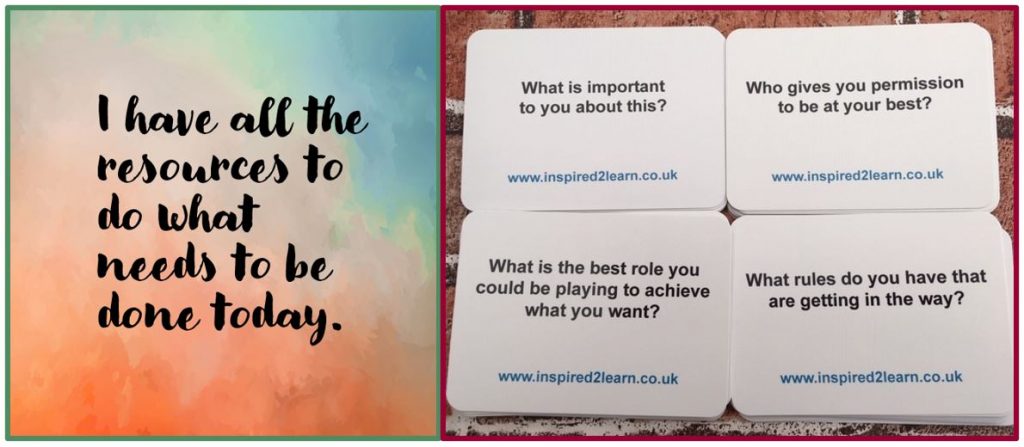If you’re in the market for coaching cards, you may be perplexed by the choices on offer. There are cards you can hold in your hand, others that you look at on a screen. Some have pictures, some have words, some have both. Some of the pictures are crystal clear and instantly recognisable, others employ the creative skills of graphic designers and cartoonists; there was definitely a fashion for stick men, though this appears (thankfully) to be passing. Some cards cram a short essay into their handy, playing card sized format, others are pithy and brief. You get my drift?
In this short guide, I’ll unpack some of the features of the main types. Perhaps more importantly, I’ll offer some suggestions which will help you make the right choice for you. All of the cards I talk about here serve a purpose for someone somewhere. Which one is best for you depends on who you are, how you show up and what you want and need.
Let’s start with Why?
As you’ve read this far, it’s clear that you either have an intention or a curiosity about buying coaching cards. For the record, let me set out what coaching cards are good for, and what they’re not. They’re great for helping you understand an issue better and decide on a course of action, particularly if you’ve grappled with that issue for a little while. Some card decks are most helpful when you find yourself in an unknown situation, when you don’t know what you don’t know. The questions on the cards may help you understand the areas you might focus on as a leader. And if you’re managing a team, they may suggest discussion points which your colleagues would find useful.
They’re not always so effective when you’ve looked at your situation from every angle over a long period and are feeling truly stuck.
By this point you may be asking, why is a coach recommending coaching cards, isn’t she doing herself out of a job? Well, turkeys don’t vote for Christmas so the short answer is no, I’m not doing myself out of a job. My purpose in work is to enable you to develop a better understanding of yourself and your situation. Sharing my insights about buying the right set of coaching cards for you is no different to me recommending that you take regular exercise or carve out time to reflect after an event as well as planning beforehand (and if you work with me, I promise I’ll do both). And so, into the detail.
Pictures vs words or Pictures and Words?
Most cards feature pictures and words, sometimes on different sides of the card. You may marvel at the manufacturers’ choice of which images go with which words, but at least when they’re on different sides of the card, you get to exercise your preference! Whichever you (and the manufacturers) choose, the purpose of those pictures and captions is to suggest and stimulate. Much of your response to words and pictures is based on your previous experiences and preferences. I recently used an image of a woman running , like the one below, in two consecutive coaching sessions.

One client told me it made her feel anxious, and the other calm. The question on the back of the card, “What value do you place on time spent on your own?” took the anxious client into a deep exploration of why she didn’t spend more time on her own, whereas the one who felt calm looking at the picture resolved quickly to give her colleagues the opportunity for more time on their own to reflect and feel calm.
Tell or discover?
Every now and then, we all benefit from someone else doing the legwork. Ready meals and ingredients delivered to our door are a success because they save time in our busy lives. The same is true for coaching cards. There’s a world of difference, however, between a statement and a question. The equivalent of the ready meal is the affirmation, a statement printed on a card, like the one on the left below . It’s designed to help you develop a positive mindset and, normally, your confidence.

Question cards, like the ones on the right above, are more like having the ingredients for a meal delivered in a box. The questions on the cards created by reputable coaching companies are handpicked and crafted to allow you to explore and organise your thoughts on a topic. Some are provocative and their purpose is to open up your thinking. A good deck should include questions from a range of perspectives, helping you look at yourself or your situation from different angles.
Roles and perspectives defined
As the market for coaching cards has matured, so has product development. There is a coaching deck for most life stages – for young people, new parents, grandparents – as well as job roles – for managers, leaders, and small business owners. The more specific the perspective, the more prescriptive the cards become, for good and ill. The best of them draw on their creators’ business and life expertise which guide you as you develop your awareness and knowledge. Others make assumptions about what you want to achieve, and about the best way to approach an issue. Occasionally unconscious bias raises its head especially around choice of images. There are, for example, few cards with culturally diverse images, and the choice of words will resonate very differently depending on where you have grown up, lived and worked.
Online or in your hand?
A welcome development, accelerated by Covid lockdowns, has been coaching cards moving online. Whether you’re after a tool to help with your work or one to explore life in general, there are now online options as well as apps to download. MBM‘s cards are business focussed and you can access part of the deck free online. Barefoot Coaching who have a wide range of card decks for different roles and situations, have developed a handy app so your coaching cards come with you, wherever you are.
At this point I should declare my own position; though I find the online versions useful, the hand-held ones are more effective for me. The simple reason is that they tap into another of our senses: touch. The greater the number of senses you employ when exploring an issue, the greater the insight. I encourage you to look at your card, speak out loud whatever question it poses or the response it evokes in you, and hold it. Your sense of touch informs your brain that something is concrete. A well-chosen card held firmly can make tangible something which has previously felt ungraspably abstract. Once it’s between your thumb and forefinger, you can create distance, or bring it closer for more intense examination. You can make it smaller, even discard it altogether!
Money, money, money
This rapid review of coaching cards wouldn’t be complete without a word about price. The good news is that coaching cards are relatively affordable with highly reputable decks costing between £10 and £20.
So, the choice is yours. Whether you prefer pictures, well chosen words or a combination of the two there are plenty of decks to choose from. If you know you want a quick and effective boost, statement cards may be the best option for you. But if you have the energy and time to explore, cards with open questions may benefit you more. And of course not everyone wants to work on their own, you may want a thinking partner to share the journey.
Whatever your decision, choose wisely and enjoy!

